
views
Improving Your Sitting Posture
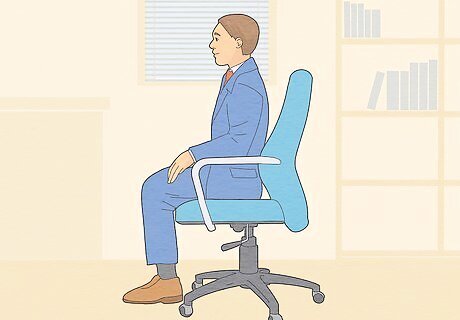
Make sure your back is at a right angle to your thighs. Keep your thighs at a right angle to your calves. Keep your shoulders straight and squared, your head upright, and your neck, back, and heels aligned. Align your back with the back of the office chair. This will help you avoid slouching or leaning forward, which you may find yourself doing after sitting too long at your desk.
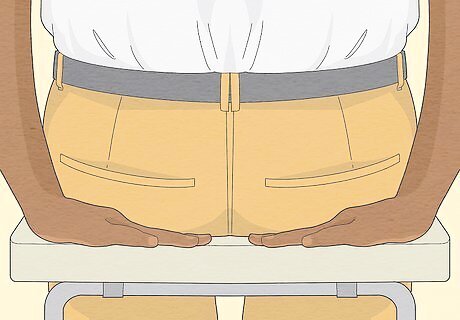
Check your posture by sitting on your hands. Put your hands under your sit bones while you are sitting on the floor. Make sure that your palms are facing down. Adjust your position until you can feel the weight centered on each of your palms. This is your optimal seated position.

Adjust your legs and keep your feet flat while sitting. Your feet should be flat on the floor, facing forward. Don't cross your legs or ankles. Make your thighs parallel to the floor. If your feet don't touch the floor, use a footrest.

Find a supportive chair to help you maintain good posture. Use a chair that's ergonomically designed for proper support, meaning it supports all of your back, even the curve at the bottom. Also, make sure it's designed for your height and weight. If you can't get a new ergonomic chair option, try using a small pillow for lumbar support in the small of your back.

Adjust your computer monitor to help with your posture. If you work on computers at an office, angle the monitor slightly upward so that it forces you to sit up. However, don't set it so high that you push your chin out to see it. You may need to move your chair up or down if you can't angle the monitor properly. Adjust your chair and your position so that your arms are flexed, not straight out. Aim for roughly a 75- to 90-degree angle at the elbows. If they are too straight, you're too far back, and if they are more than 90 degrees, you're either sitting too close or you're slouching.
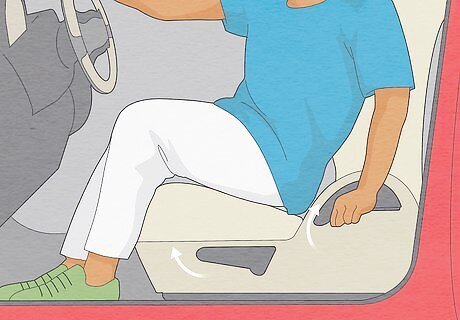
Make adjustments to your seat to maintain good posture while driving. Adjust your seat to maintain a proper distance from the pedals and steering wheel. If you're leaning forward, pointing your toes, or reaching for the wheel, you're too far away. If you are bunched up with your chin on top of the steering wheel, you're too close. Use lumbar support for the curve of your back when possible. Adjust the head rest so the middle of your head rests against it. Your head shouldn't be more than 4 inches (10 cm) away from the headrest while driving. Keep your back against the seat and your head against the head rest. Your knees should be at the same level as your hips or slightly above. Good posture is also important for safety in the car. Your car's protective systems protect you best when you are sitting properly in the seat.

Take standing breaks when you're sitting for long periods. Even if you're using perfect posture while sitting, you need to stand up and stretch or walk every hour or so. Just walking around the room or getting out of your car for a few minutes can help. If you tend to get engrossed in your work, set an alarm to remind yourself to take a break. In addition, these breaks are also good for your health as your body needs movement throughout the day.
Improving Your Standing and Walking Posture

Find your center by standing up straight and tall. Keep your chin level with the ground, your shoulders back, and your stomach in. Let your arms fall naturally at your sides. Place your feet about shoulder-width apart, the same stance you would use for working out. Imagine a string holding you up. As you stand tall, imagine a string is coming from the ceiling, pulling you upwards. Keep your lower back inline, and don't move to your tiptoes. Visualization techniques like this one can guide your sense of the proper position you should be in.

Use a wall to teach yourself correct posture. Stand with your back against a door or wall. Just touch the wall with the back of your head, your shoulders, and your butt. Your heels should be 2 to 4 inches (5.1 to 10.2 cm) away from the wall. Slide your hand behind your back to check for space. You should be able to slide your hand behind your back but only by a little bit. If you have more space than that, pull your belly button back towards your spine to help flatten your back a little. If you can't slide your hand behind your back, arch your back so that you can. Try to hold this position as you move away from the wall, rechecking as needed. Away from the wall, if you simply put your head back, tuck your chin in, and pull your abdominals in, then you will find that your spine, shoulders, and chest automatically go into the positions that they're supposed to be in for good posture. Think about it: If you put your head back and tuck your chin in, then your chest will automatically be out front. And the good change in spine position will automatically push your shoulders back, to the correct position, and encourage the proper curve to the middle of your back (near the bottom of the rib cage). Then, it becomes quick and easy to think: "Head back, chin tucked, abs in." Go back to the wall again and notice that the wall actually guides you to achieve this very posture of "Head back, chin tucked, abs in"
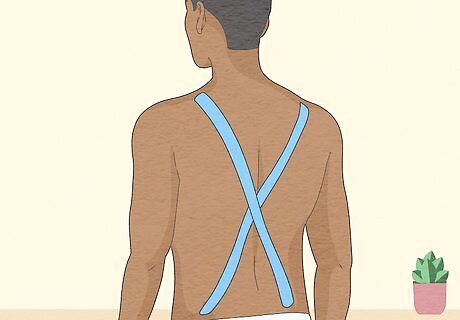
Have someone tape an X on your back to help correct your posture. Make an "X" from your shoulders to your hips. Add a straight line of tape across your shoulders closing the top of the X. Wear this during the day to help retrain your back. This technique works really well if you hold your shoulders back before taping. Use a tape meant for skin, such as a medical tape. Instead of tape, you can buy a posture corrector online.
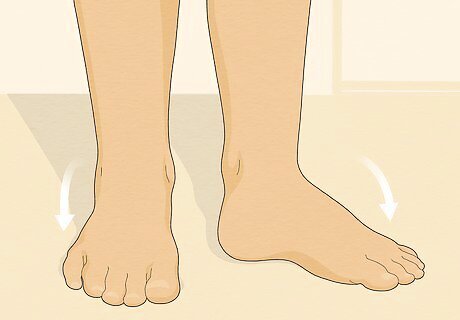
Keep your weight on the balls of your feet. When you rest on your heels, your natural tendency will be to slouch. Instead, stand up straight, shifting your weight forward a bit. Now rock back so that your weight is on your heels. Notice the way your entire body shifts into a "slouchy" posture with this single motion.
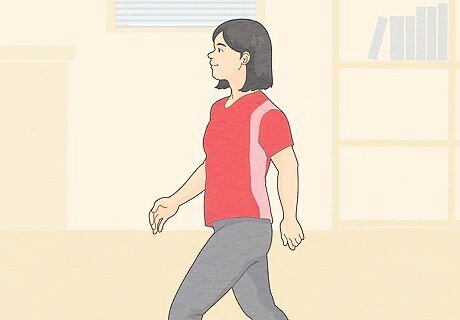
Walk as if you have a book balanced on your head. Imagining a book on your head will help you keep your head up and your back straight. If you're having trouble imagining it, try a real book for a few minutes. Have a good standing posture while moving. Walking with good posture is simply an extension of standing with good posture. Keep your head up, shoulders back, chest out, and eyes looking straight ahead while you walk. Avoid pushing your head forward.
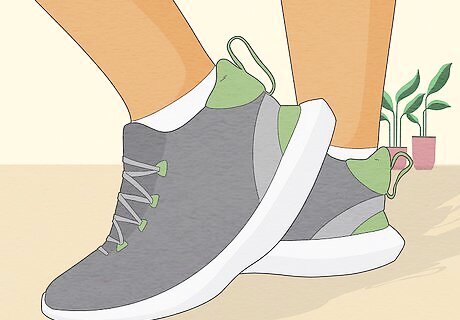
Pick supportive footwear for standing and walking. Choose shoes that have ample padding to help you hold yourself upright. In addition, make sure they have good arch support. Good posture starts with your feet. Avoid shoes with high heels, as they can change your body's alignment. If you're standing for long periods, add padding to the floor for additional comfort.
Maintaining Good Posture While Sleeping
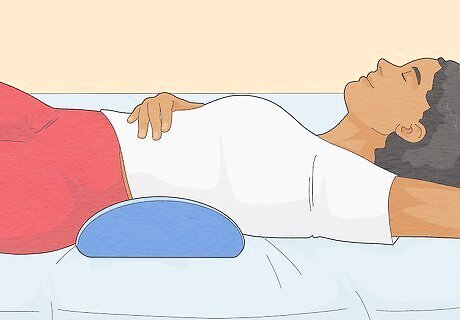
Provide support for your back with pillows while sleeping. No matter whether you sleep on your back, stomach, or side, adding pillows can help provide support. Basically, you want to add a pillow anywhere there's a space between your body and the mattress. For instance, if you sleep on your stomach, which is the worst position for your back and posture, place a flat pillow under your stomach to provide support. Choose a flat pillow or no pillow for your head. If you sleep on your back, place a small pillow behind your knees, and choose a supportive pillow for your head. If you sleep on your side, place a pillow between your knees and pull them up towards your chest. Pick a pillow for your head that keeps your spine straight, or use a full body pillow.
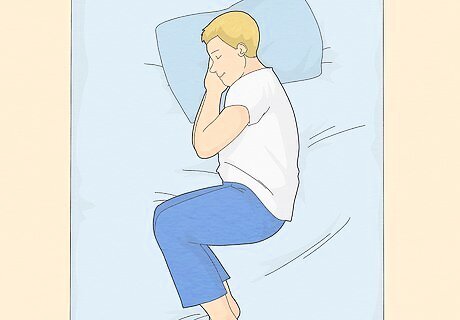
Turn your body as 1 unit when laying down. Avoid turning at your waist while you are in bed. Instead, keep your back straight and your stomach muscles tight, and turn your whole body when you want to reposition yourself.
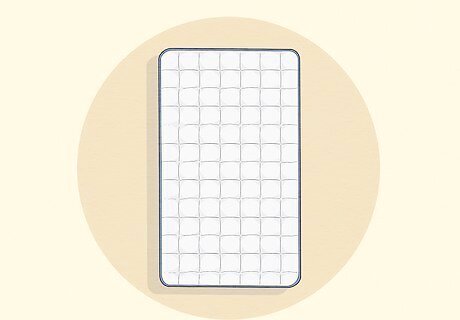
Sleep with good posture by choosing a comfortable mattress. While you may have heard that one mattress or another is best for a healthy back, the truth is whatever works for you is best. Choose one that lets you rest comfortably and wake up pain free. Remember to replace your mattress every decade or so. If your mattress isn't providing the support you need, add a board between the box springs and mattress, which should keep it from sagging.
Using Exercises to Fix Bad Posture

Improve your core muscles with deep abdominal stretching. Lie on your back, with your legs bent to about 90 degrees at the knee and your feet on the floor. Pull your bellybutton up towards your chest and hold it for 10 seconds. Your core muscles are essential to support your posture, so the more you can work them, the better your posture will be. Repeat 8 times, and practice it daily. Breathe normally during this exercise, as you are training your core to be able to maintain this position during normal activities in daily life. EXPERT TIP Eric Christensen, DPT Eric Christensen, DPT Physical Therapist Eric Christensen is a Physical Therapist based in Chandler, Arizona. With over a decade of experience, Eric works in both orthopedic and neurological fields and specializes in custom orthotic prescription and casting, vestibular reprogramming, and manual therapy. He holds a Bachelor’s degree in Exercise Science with a focus in Sports Medicine from Colorado State University and a Doctor of Physical Therapy from Regis University. In practice, Eric takes a developmental approach to rehabilitation utilizing the Selective Functional Movement Assessment. He uses functional movement patterning and manual therapy to return patients to prior levels of function. Eric Christensen, DPT Eric Christensen, DPT Physical Therapist Strengthen your posture naturally. Posture braces can help remind you to stand up straight, but relying on them too much can weaken the muscles that support good posture. It’s better to actively work on your posture, doingg exercises that strengthen your back and shoulders so you can maintain your posture on your own.

Do a shoulder blade squeeze. While sitting in a chair, sit up straight and squeeze your shoulder blades together. Hold for a count of 5, and then release. Repeat this 3 or 4 times daily. You can also use exercise bands to increase the resistance for a stretch like this.
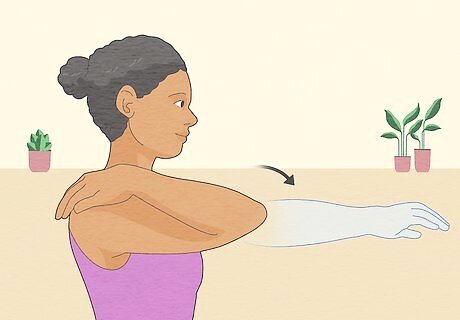
Train your muscles for better posture with strength training. Exercises that strengthen the muscles across your upper back and shoulders help you maintain good posture. Try the following strength exercise, with or without hand weights: Start by squaring your posture. Extend both arms straight out in front of you with your palms up. Bend your forearms toward your shoulders, trying to touch your shoulder blades with your fingertips. Do 10 repetitions with both arms, then alternate 10 reps for each arm by itself.
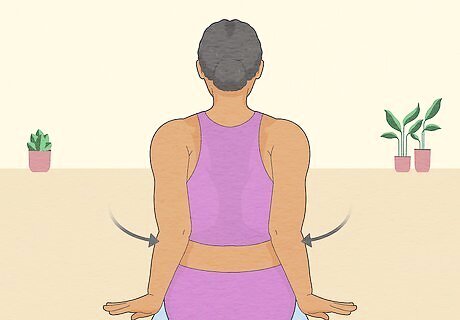
Pretend you're a penguin to stretch your shoulders. While you wait for a web page to load or the bread to toast, place your elbows at your side, and touch your shoulders with your hands, creating your "penguin wings." Keeping your hands on your shoulders and your ears aligned, raise both elbows (count 1, 2) and lower them back down (count 1, 2). Do as many reps as your wait allows. You'll be surprised how many stretches fit into 30 seconds.

Use stretching for a sore neck or back. Tilt or stretch your head in all 4 directions over your shoulders (forward, back, left, right), and gently massage your neck. Avoid rolling your head in a circle, as it may cause further strain. For another exercise, get on your hands and knees. Curl your back upwards, like a cat, and then do the opposite, dropping your stomach down and curling your back downwards. Repeat the exercises a few times each day. Doing them in the morning helps your body stretch out the muscle lethargy from sleep. Doing periodically throughout the day will help to raise your energy level.
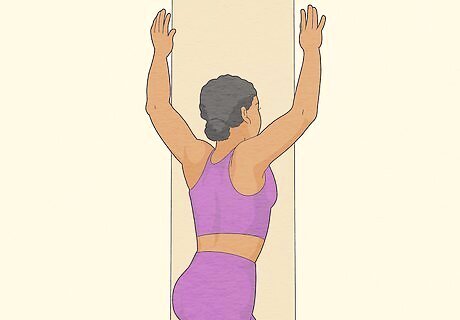
Try a doorway pec stretch for your chest. Put your arm against a door frame with your elbow about 2–3 in (5.1–7.6 cm) higher than your shoulders. Step forward with the leg that's on the same side as the arm you've propped up, and lean your weight on your arm. You should feel a pull from the front of your chest through your shoulder.

Try a foam roller to open up your chest and shoulders. Lay on the floor with a foam roller underneath your back, running lengthwise from the back of your head down to your tailbone. Let your arms drop to the side and take a deep breath as you relax. This will help stretch all of the muscles in your chest, back, and shoulders. This is a good exercise if you tend to spend a lot of time sitting hunched over a computer for work.
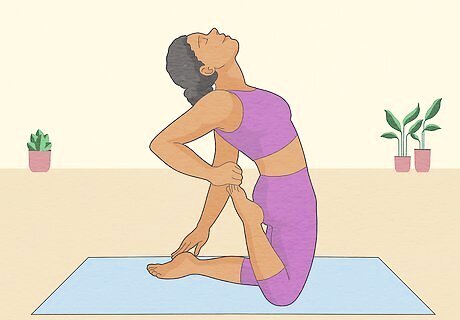
Practice yoga to increase flexibility and help with posture. Yoga is excellent for posture and for your health in general. It can also improve your balance. Yoga works your core muscles, making them stronger and helping you to keep a proper body alignment. Yoga will also help by teaching you how to hold an erect posture while sitting, standing, and walking. Look for classes in your area, or scout YouTube for instructional videos.




















Comments
0 comment